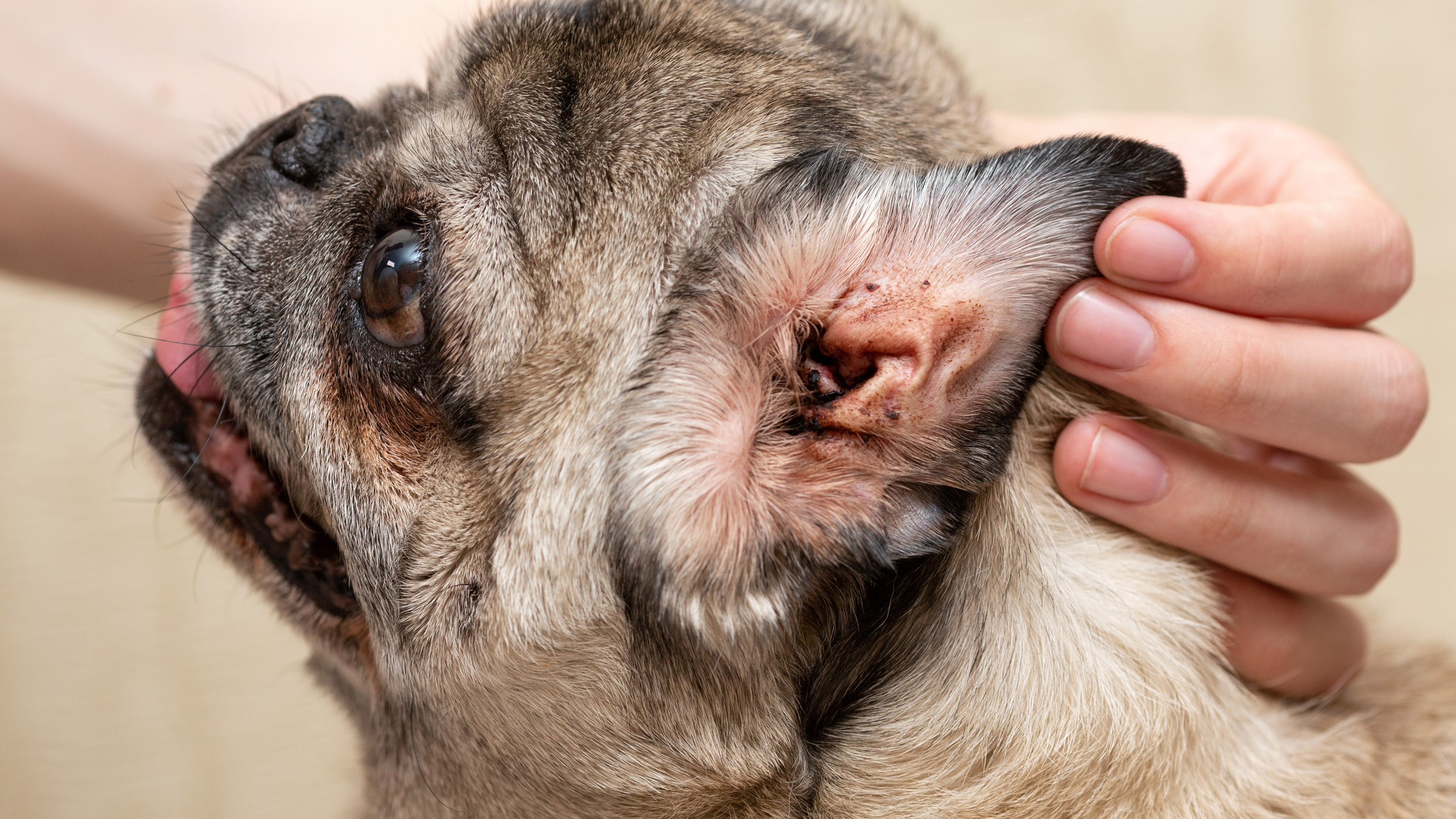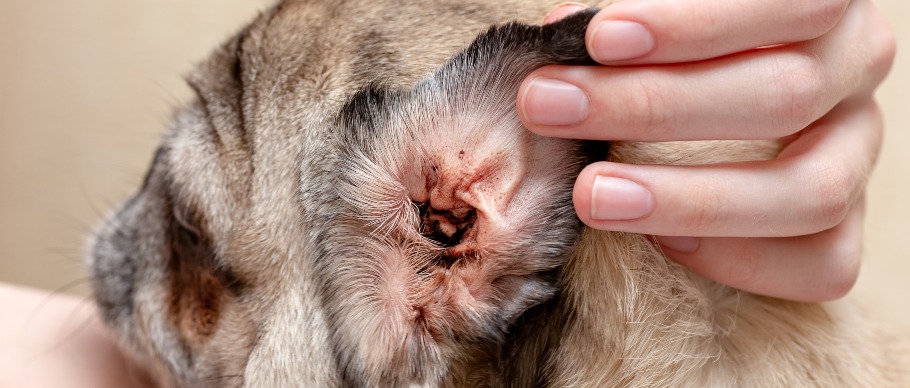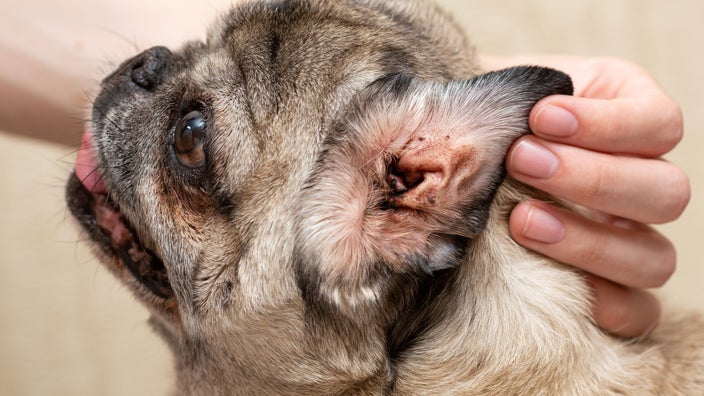To tell if your dog has ear mites, look for constant itching and scratching at the ears, as well as brown or black waxy ear secretions and a strong odor.

Credit: bayshore-vet.com
Understanding Ear Mites In Dogs
Ear mites are a common parasitic problem in dogs that can cause discomfort and irritation. These tiny, spider-like creatures are known to infest the ears of dogs, leading to a range of symptoms. In this section, we will explore what ear mites are, how dogs get them, and the common symptoms to look out for.
What Are Ear Mites?
Ear mites, scientifically known as Otodectes cynotis, are small parasites that primarily affect the ears of dogs. They belong to the arachnid family and are barely visible to the naked eye, making it difficult to detect them without proper examination.
How Do Dogs Get Ear Mites?
Dogs can contract ear mites through various sources, including direct contact with other infested animals or sharing bedding and toys. These mites can quickly spread from one dog to another in environments such as kennels, shelters, or crowded dog parks.
Common Symptoms Of Ear Mites In Dogs
It’s essential to identify the signs of ear mite infestation in dogs to seek timely treatment. Some of the common symptoms to watch out for include:
- Scratching and rubbing at the ears: Dogs with ear mites often display intense itching in their ears, leading to constant scratching and rubbing.
- Shaking the head: Dogs may frequently shake their heads in an attempt to alleviate the discomfort caused by the mites.
- Dark discharge from the ears: Ear mites can cause an accumulation of waxy, black or brown discharge in the ears, which is a telltale sign of infestation.
- Hair loss, skin lesions, and secondary skin infections: Due to persistent scratching and rubbing, dogs may develop hair loss, skin lesions, and secondary skin infections around the ears, head, and neck.
If you suspect your dog may have ear mites, it is crucial to consult with a veterinarian for proper diagnosis and treatment. Remember, prompt intervention can help prevent further discomfort and potential complications for your furry friend.
Diagnosing Ear Mites In Dogs
Ear mites can be a common problem for dogs, especially those that spend a lot of time outdoors. It is important to diagnose and treat ear mites promptly to prevent discomfort and potential complications. Here are some methods to help you diagnose ear mites in your dog:
Conducting A Visual Examination
A visual examination of your dog’s ears can provide some clues about the presence of ear mites. Take a close look at the inside of your dog’s ears using a flashlight. Look for signs of infestation, such as:
- Visible mites crawling inside the ear canal
- Dark discharge that resembles coffee grounds
- Redness or inflammation of the ear canal
If you notice any of these signs, it is important to consult a veterinarian for further evaluation.
Using A Microscope To Identify Mites
In some cases, a visual examination may not be enough to confirm the presence of ear mites. A veterinarian may need to use a microscope to examine a sample of the ear debris. This allows them to identify the mites or their eggs more accurately. The veterinarian will gently swab the inside of your dog’s ear to collect a sample for examination.
| Benefits of using a microscope: |
|---|
| Accurate identification of ear mites |
| Ability to differentiate ear mites from other types of ear infections |
| Guides the appropriate treatment plan |
Obtaining A Sample Of Ear Debris For Testing
In some cases, a veterinarian may recommend sending a sample of your dog’s ear debris for testing. This is especially important if the diagnosis is not clear or if the symptoms persist despite treatment. The sample will be sent to a laboratory, where it will be examined under a microscope or subjected to other diagnostic tests to confirm the presence of ear mites.
- Provides a definitive diagnosis of ear mites
- Helps rule out other possible causes of ear problems
- Ensures appropriate and targeted treatment
In conclusion, diagnosing ear mites in dogs requires careful examination and sometimes laboratory testing. It is important to consult a veterinarian if you suspect your dog has ear mites, as they can recommend the best course of treatment to alleviate your dog’s discomfort and eliminate the infestation.
Treating And Preventing Ear Mites In Dogs
Spotting ear mites in dogs can be challenging as they are tiny, but some signs to look out for are brown or black waxy ear secretions and a strong odor from the ears. Scratching, head shaking, and dark discharge from the ears are other symptoms that may indicate the presence of ear mites in dogs.
Medication Options For Treating Ear Mites
When it comes to treating ear mites in dogs, there are several medication options available. You can consult with your veterinarian to determine the best course of action for your furry friend. Some commonly used medications for treating ear mites include:1. Prescription ear drops: Your vet may prescribe a medicated ear drop solution that contains ingredients to kill the mites and alleviate any discomfort. These drops are typically applied directly into the ear canal, and it’s essential to follow your vet’s instructions on dosage and frequency. 2. Topical ointments: In some cases, your vet may recommend a topical ointment to be applied to the affected area. These ointments can help soothe the skin and reduce inflammation caused by the mites. It’s important to follow the instructions provided by your vet and apply the ointment as directed.3. Oral medications: In more severe cases, oral medications may be prescribed to treat ear mites. These medications are typically in the form of tablets or chewable treats and work by killing the mites from within the body. Again, it’s crucial to administer the medication according to your vet’s instructions.Cleaning And Caring For Infected Ears
Proper cleaning and care of your dog’s infected ears are essential for effective treatment and prevention of ear mites. Here are some steps you can take:1. Use a gentle cleanser: Your vet may recommend a specific ear cleanser to use for cleaning your dog’s ears. These cleansers are designed to help remove debris, earwax, and mite eggs from the ear canal. Follow the instructions provided by your vet for proper application and frequency.2. Apply the cleanser correctly: Gently lift your dog’s ear flap and apply a few drops of the cleanser into the ear canal. Massage the base of the ear for a few seconds to help distribute the cleanser. Your dog may shake their head afterward, which is normal. Use a clean cloth or cotton ball to wipe away any excess cleanser and debris.3. Keep the ears dry: Moisture can create an environment where mites thrive, so it’s crucial to keep your dog’s ears dry. Avoid swimming or bathing your dog until the infection has cleared, and make sure to dry their ears thoroughly after any water exposure.Preventive Measures Against Ear Mites In Dogs
Prevention is key when it comes to protecting your dog from ear mites. Here are some preventive measures you can take:Maintain good ear hygiene: Regularly check and clean your dog’s ears to prevent the build-up of debris and wax. Use a gentle ear cleanser and follow the same steps mentioned earlier to keep your dog’s ears clean and healthy.Regular vet check-ups: Schedule regular check-ups with your vet to ensure your dog’s overall health. During these visits, your vet can inspect your dog’s ears and detect any potential issues, including ear mites, early on.Avoid contact with infected animals: If you know or suspect that an animal has ear mites, it’s crucial to avoid direct contact between your dog and the infected animal. Ear mites can be easily transmitted through close contact, so it’s best to keep your dog away from potentially infected animals. By following these steps and being proactive about your dog’s ear health, you can help prevent ear mites and ensure your furry friend stays happy and healthy. Remember, if you suspect your dog has ear mites or any other health concern, always consult with your veterinarian for proper diagnosis and treatment.
Credit: www.goodrx.com

Credit: www.fourpaws.com
Frequently Asked Questions On How To Tell If Your Dog Has Ear Mites
How Do You Get Rid Of Ear Mites In Dogs?
To get rid of ear mites in dogs, highly effective treatments like NexGard® or NexGard SPECTRA® for Dogs can be used. These treatments are given in a single dose and can effectively treat ear mites in puppies and dogs. It’s important to note that dogs with ear mites may develop secondary ear infections, which may require additional treatment.
Symptoms of ear mites include constant ear scratching, dark ear secretions, and a strong odor.
How Do You Tell If Your Dog Has Ear Mites Or Just Dirty Ears?
If your dog has constant itching and scratching at the ears, along with brown or black waxy ear secretions and a strong odor, it may have ear mites. Use a soft cloth to wipe the ears and look for tiny white dots, which are the mites.
How Do Dogs Act When They Have Ear Mites?
Dogs with ear mites may scratch and rub their ears, shake their heads, have dark discharge, hair loss, and skin infections.
How Can I Tell If My Dog Has Mites?
If your dog has mites, look out for symptoms such as hair loss, dandruff, excessive scratching, and visible irritation like red skin. You may even be able to spot mites on their skin if you part their fur and take a close look.
Conclusion
If you notice your dog constantly scratching and rubbing at their ears, it could be a sign of ear mites. These tiny pests can be difficult to spot, but you may be able to see them as tiny white dots in the residue when you clean your dog’s ears.
Other symptoms to look out for include brown or black waxy ear secretions and a strong odor. Fortunately, there are effective treatments available to help get rid of ear mites in dogs. If you suspect your dog has ear mites, it is important to consult with your veterinarian for proper diagnosis and treatment.



